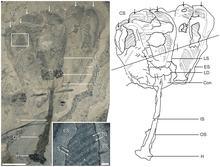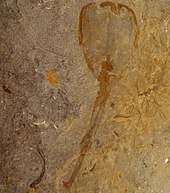Siphusauctum
Siphusauctum is an extinct genus of filter-feeding animals that lived during the Middle Cambrian about 510 million years ago. Attached to the substrate by a holdfast, it had a tulip-shaped body, called the calyx, into which it actively pumped water that entered through pores and filtered out and digested organic contents. It grew to a length of only about 20 cm (7.9 in).
| Siphusauctum | |
|---|---|
 | |
| Holotype of Siphusauctum gregarium | |
| Scientific classification | |
| Kingdom: | |
| (unranked): | |
| Family: | †Siphusauctidae O'Brien & Caron, 2012 |
| Genus: | †Siphusauctum O'Brien & Caron, 2012 |
| Species | |
| |
Siphusauctum gregarium was described in 2012 from numerous fossils recovered from the "Tulip Beds" strata of the Burgess Shale of Yoho National Park, British Columbia, Canada. The generic name comes Latin siphus ("cup" or "goblet") and auctus ("large"), referring to the general shape and size of the animal. The specific epithet comes from Latin gregalis ("flock" or "herd") referring to the large numbers of specimens recovered. It is the only species classified under the genus Siphusauctum and the family Siphusauctidae.[1]
In 2017 a new species, Siphusauctum lloydguntheri, was reported from the Middle Cambrian Spence Shale of Utah.[2]
References
- Lorna J. O'Brien & Jean-Bernard Caron (2012). "A new stalked filter-feeder from the Middle Cambrian Burgess Shale, British Columbia, Canada". PLoS ONE. 7 (1): e29233. doi:10.1371/journal.pone.0029233. PMC 3261148. PMID 22279532.
- Julien Kimmig, Luke C. Strotz & Bruce S. Lieberman (2017). "The stalked filter feeder Siphusauctum lloydguntheri n. sp. from the middle Cambrian (Series 3, Stage 5) Spence Shale of Utah: its biological affinities and taphonomy". Journal of Paleontology. doi:10.1017/jpa.2017.57.

| Wikimedia Commons has media related to Siphusauctum. |